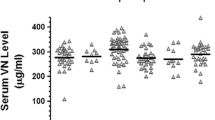Summary
Thirty-eight human cancer cell lines and subclones derived from 12 different organs were screened for vitronectin secretion in their culture media. By immunoblotting analysis we detected high secretion by three out of five hepatoma cell lines tested but no secretion by the others. In addition, significant secretion was observed in seven non-hepatic cancer cell lines and subclones derived from the cervix, lung, and pancreas. These vitronectin-secreting cells included PLC/PRF/5, HuH-6 #5, HuH-7, HeLa S3, HeLa · P3 #2, #3, #6, #8, A549, and MIAPaCa-2. The results were further confirmed by quantitative analysis using sandwich enzyme-linked immunoassay, and activity analysis of cell attachment promotion on Western blotted filters.
Similar content being viewed by others
References
Albelda, S. M.; Mette, S. A.; Elder, D. E., et al. Integrin distribution in malignant melanoma: association of theβ3 subunit with tumor progression. Cancer Res. 50:6757–6764; 1990.
Barnes, D. W.; Reing, J. Human spreading factor: synthesis and response by HepG2 hepatoma cells in culture. J. Cell. Physiol. 125:207–214; 1985.
Barsky, S. H.; Rao, C. N.; Williams, J. E., et al. Laminin molecular domain which alter metastatic in a murine model. J. Clin. Invest. 74:843–848; 1984.
Boukerche, H.; Berthier-Vergnes, O.; Bailly, M., et al. A monoclonal antibody (LYP18) directed against the blood platelet glycoprotein IIb/IIIa complex inhibits human melanoma growthin vivo. Blood 74:909–912; 1989.
Cooper, S.; Pera, M. F. Vitronectin production by human yolk sac carcinoma cells resembling parietal endoderm. Development 104:565–574; 1988.
Doi, I.; Namba, M.; Sato, J. Establishment and some biological characteristics of human hepatoma cell lines. Gann 66:385–392; 1975.
Gladson, C. L.; Cheresh, D. A. Glioblastoma expression of vitronectin and theαVβ3 integrin. J. Clin. Invest. 88:1924–1932; 1991.
Hart, I. R. The spread of tumors. In: Franks, L. M.; Teich, N. M., eds. Introduction to the cellular & molecular biology of cancer. New York: Oxford University Press; 1991:31–46.
Hayman, E. G.; Engvall, E.; Ahearn, E., et al. Cell attachment on replicas of SDS polyacrylamide gels reveals two adhesive plasma proteins. J. Cell Biol. 95:20–23; 1982.
Hetland, G.; Petteersen, H. B.; Mollnes, T. E., et al. S-Protein is synthesized by human monocytes and macrophagesin vitro. Scand. J. Immunol. 29:15–21; 1989.
Katsuta, H.; Takaoka, T. Cultivation of cells in protein- and lipid-free synthetic media. In: Prescott, D. M., ed. Methods in cell biology VI. New York: Academic Press; 1973:1–42.
Kitagaki-Ogawa, H.; Yatohgo, T.; Izumi, M., et al. Diversities in animal vitronectins. Differences in molecular weight, immunoreactivity and carbohydrate chains. Biochim. Biophys. Acta 1033:49–56; 1990.
Koli, K.; Lohi, J.; Hautanen, A., et al. Enhancement of vitronectin expression in human HepG2 hepatoma cells by transforming growth factor-β1. Eur. J. Biochem. 199:337–345; 1991.
Kyhse-Andersen, J. Electroblotting of multiple gels: a simple apparatus without buffer tank for rapid transfer of proteins from polyacrylamide to nitrocellulose. J. Biochem. Biophys. Methods 10:203–209; 1984.
Laemmli, U. K. Cleavage of structural proteins during the assembly of the head of bacteriophage T4. Nature 227:680–685; 1970.
Liotta, L. A. Tumor invasion and metastasis—role of the extracellular matrix: Rhoads memorial award lecture. Cancer Res. 46:1–7; 1986.
Liotta, L. A.; Rao, C. N.; Wewer, U. M. Biochemical interaction of tumor cells with the basement membrane. Ann. Rev. Biochem. 55:1037–1057; 1986.
Miyazaki, K.; Hattori, Y.; Umenishi, F., et al. Purification and characterization of extracellular matrix-degrading metalloproteinase, Matrin (Pump-1), secreted from human rectal carcinoma cell line. Cancer Res. 50:7758–7764; 1990.
Morita, H.; Yasumitsu, H.; Harada, H., et al. Secretion of a novel cell-adhesive protein distinct from fibronectin by mouse L · P3 cells growing in protein-and lipid-free synthetic medium. Cell Struct. Funct. 13:481–493; 1988.
Nakabayashi, H.; Taketa, K.; Miyano, K., et al. Growth of human hepatoma cell lines with differentiated functions in chemically defined medium. Cancer Res. 42:3858–3862; 1982.
Seiffert, D.; Wagner, N. N.; Loskutoff, D. J. Serum-derived vitronectin influences the pericellular distribution of type 1 plasminogen activator inhibitor. J. Cell Biol. 111:1283–1291; 1990.
Seiffert, D.; Keeton, M.; Eguchi, Y., et al. Detection of vitronectin mRNA in tissues and cells of the mouse. Proc. Natl. Acad. Sci. USA 88:9402–9406; 1991.
Shaughnessy, S. G.; Lafrenie, R. M.; Buchanan, M. R., et al. Endothelial cell damage by Walker carcino sarcoma cells is dependent on vitronectin receptor-mediated tumor cell adhesion. Am. J. Pathol. 138:1535–1543; 1991.
Solem, M.; Helmrich, A.; Collodi, P., et al. Human and mouse S-protein mRNA detected in Northern experiments and evidence for the gene coding S-protein in mammals by Southern blot analysis. Mol. Cell. Biochem. 100:141–149; 1991.
Terranova, V. P.; Williams, J. E.; Liotta, L. A., et al. Modulation of metastatic activity of melanoma cells by laminin and fibronectin. Science 226:982–985; 1984.
Tomasini, B. R.; Mosher, D. F. Vitronectin. Prog. Hemostasis Thromb. 10:269–305; 1990.
Umeda, M.; Noda, K.; Takaoka, T. Establishment of cell lines growing in complete protein- and lipid-free medium. In: Murakami, H.; Yamane, I.; Barnes, D. W., et al., eds. Growth and differentiation of cells in defined environment. Tokyo: Kodansha & Springer-Verlag; 1985:77–82.
Yasumitsu, H.; Miyazaki, K.; Umenishi, F., et al. Comparison of extracellular matrix-degrading activities between 64-kDa and 90-kDa gelatinases purified in inhibitor-free forms from human schwannoma cells. J. Biochem. 111:74–80; 1992.
Zetter, B. R. The cellular basis of site-specific tumor metastasis. N. Engl. J. Med. 322:605–612; 1990.
Author information
Authors and Affiliations
Rights and permissions
About this article
Cite this article
Yasumitsu, H., Seo, N., Misugi, E. et al. Vitronectin secretion by hepatic and non-hepatic human cancer cells. In Vitro Cell Dev Biol - Animal 29, 403–407 (1993). https://doi.org/10.1007/BF02633989
Received:
Accepted:
Issue Date:
DOI: https://doi.org/10.1007/BF02633989




